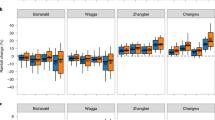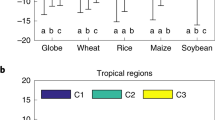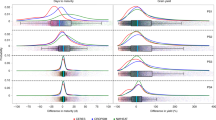Abstract
Increasing the accuracy of crop productivity estimates is a key element in planning adaptation strategies to ensure global food security under climate change. Process-based crop models are effective means to project climate impact on crop yield, but have large uncertainty in yield simulations. Here, we show that variations in the mathematical functions currently used to simulate temperature responses of physiological processes in 29 wheat models account for >50% of uncertainty in simulated grain yields for mean growing season temperatures from 14 °C to 33 °C. We derived a set of new temperature response functions that when substituted in four wheat models reduced the error in grain yield simulations across seven global sites with different temperature regimes by 19% to 50% (42% average). We anticipate the improved temperature responses to be a key step to improve modelling of crops under rising temperature and climate change, leading to higher skill of crop yield projections.
This is a preview of subscription content, access via your institution
Access options
Access Nature and 54 other Nature Portfolio journals
Get Nature+, our best-value online-access subscription
$29.99 / 30 days
cancel any time
Subscribe to this journal
Receive 12 digital issues and online access to articles
$119.00 per year
only $9.92 per issue
Buy this article
- Purchase on Springer Link
- Instant access to full article PDF
Prices may be subject to local taxes which are calculated during checkout




Similar content being viewed by others
Change history
27 September 2017
In the original version of this Article, the name of one co-author was omitted. This has now been corrected by the addition of Benjamin Dumont to the author list.
References
Porter, J. R. & Semenov, M. A. Crop responses to climatic variation. Philos. T. Roy. Soc. B: Biological Sciences 360, 2021–2035 (2005).
Liu, B. et al. Similar estimates of temperature impacts on global wheat yield by three independent methods. Nat. Clim. Change 6, 1130–1136 (2016).
Asseng, S. et al. Uncertainty in simulating wheat yields under climate change. Nat. Clim. Change 3, 827–832 (2013).
Rosenzweig, C. et al. The agricultural model intercomparison and improvement project (AgMIP): protocols and pilot studies. Agr. Forest Meteorol. 170, 166–182 (2013).
Rotter, R. P., Carter, T. R., Olesen, J. E. & Porter, J. R. Crop-climate models need an overhaul. Nat. Clim. Change 1, 175–177 (2011).
Li, T. et al. Uncertainties in predicting rice yield by current crop models under a wide range of climatic conditions. Glob. Change Biol. 21, 1328–1341 (2015).
Bassu, S. et al. How do various maize crop models vary in their responses to climate change factors? Glob. Change Biol. 20, 2301–2320 (2014).
Asseng, S. et al. Rising temperatures reduce global wheat production. Nat. Clim. Change 5, 143–147 (2015).
Wall, G. W., Kimball, B. A., White, J. W. & Ottman, M. J. Gas exchange and water relations of spring wheat under full-season infrared warming. Glob. Change Biol. 17, 2113–2133 (2011).
White, J. W., Kimball, B. A., Wall, G. W., Ottman, M. J. & Hunt, L. A. Responses of time of anthesis and maturity to sowing dates and infrared warming in spring wheat. Field Crop. Res. 124, 213–222 (2011).
Reynolds, M., Balota, M., Delgado, M., Amani, I. & Fischer, R. Physiological and morphological traits associated with spring wheat yield under hot, irrigated conditions. Funct. Plant Biol. 21, 717–730 (1994).
Reynolds, M. P. et al. The International Heat Stress Genotype Experiment: results from 1990-1992 (CIMMYT, DF, 1994).
Parent, B. & Tardieu, F. Temperature responses of developmental processes have not been affected by breeding in different ecological areas for 17 crop species. New Phytol. 194, 760–774 (2012).
Parent, B., Turc, O., Gibon, Y., Stitt, M. & Tardieu, F. Modelling temperature-compensated physiological rates, based on the co-ordination of responses to temperature of developmental processes. J. Exp. Bot. 61, 2057–2069 (2010).
Wang, E. & Engel, T. Simulation of phenological development of wheat crops. Agric. Syst. 58, 1–24 (1998).
Yin, X. & Struik, P. C. C3 and C4 photosynthesis models: an overview from the perspective of crop modelling. NJAS WAGEN J LIFE SC 57, 27–38 (2009).
Atkin, O. K. & Tjoelker, M. G. Thermal acclimation and the dynamic response of plant respiration to temperature. Trends Plant Sci. 8, 343–351 (2003).
O'Sullivan, O. S. et al. High-resolution temperature responses of leaf respiration in snow gum (Eucalyptus pauciflora) reveal high-temperature limits to respiratory function. Plant Cell Environ. 36, 1268–1284 (2013).
Martre, P., Porter, J. R., Jamieson, P. D. & Triboï, E. Modeling grain nitrogen accumulation and protein composition to understand the sink/source regulations of nitrogen remobilization for wheat. Plant Physiol. 133, 1959–1967 (2003).
Hunt, L. A., van der Poorten, G. & Pararajasingham, S. Postanthesis temperature effects on duration and rate of grain filling in some winter and spring wheats. Can. J. Plant Sci. 71, 609–617 (1991).
Sofield, I., Evans, L., Cook, M. & Wardlaw, I. Factors influencing the rate and duration of grain filling in wheat. Funct. Plant Biol. 4, 785–797 (1977).
Wang, E. & Engel, T. SPASS: a generic process-oriented crop model with versatile windows interfaces. Environ. Modell. Softw. 15, 179–188 (2000).
Triboï, E., Martre, P. & Triboï-Blondel, A.-M. Environmentally-induced changes in protein composition in developing grains of wheat are related to changes in total protein content. J. Exp. Bot. 54, 1731–1742 (2003).
Nagai, T. & Makino, A. Differences between rice and wheat in temperature responses of photosynthesis and plant growth. Plant Cell Physiol. 50, 744–755 (2009).
Zhao, Z. et al. Accuracy of root modelling and its impact on simulated wheat yield and carbon cycling in soil. Field Crop. Res. 165, 99–110 (2014).
Fleisher, D. H. et al. A potato model intercomparison across varying climates and productivity levels. Glob. Change Biol. 23, 1258–1281 (2017).
Ottman, M. J., Kimball, B. A., White, J. W. & Wall, G. W. Wheat growth response to increased temperature from varied planting dates and supplemental infrared heating. Agron. J. 104, 7–16 (2012).
Qualset, C. O., Vogt, H. E. & Borlaug, N. E. Registration of ‘Yecora Rojo’ wheat. Crop Sci. 25, 1130 (1985).
Reynolds, M. P. in Wheat in heat stressed environments: irrigated dry areas and rice-wheat farming systems (eds Saunders, D.A. & Hettel, G.P. ) 184–192 (DF, 1993).
Wang, E. & Engel, T. Simulation of growth, water and nitrogen uptake of a wheat crop using the SPASS model. Environ. Modell. Softw. 17, 387–402 (2002).
Streck, N. A., Weiss, A., Xue, Q. & Stephen Baenziger, P. Improving predictions of developmental stages in winter wheat: a modified Wang and Engel model. Agr. Forest Meteorol. 115, 139–150 (2003).
Xue, Q., Weiss, A. & Baenziger, P. S. Predicting phenological development in winter wheat. Climate Res. 25, 243–252 (2004).
Streck, N. A., Lago, I., Gabriel, L. F. & Samboranha, F. K. Simulating maize phenology as a function of air temperature with a linear and a nonlinear model. Pesquisa Agropecuária Brasileira 43, 449–455 (2008).
Streck, N. A., Bosco, L. C. & Lago, I. Simulating leaf appearance in rice . Agron. J. 100, 490–501 (2008).
Streck, N. A., Uhlmann, L. O., Zanon, A. J. & Bisognin, D. A. Impact of elevated temperature scenarios on potato leaf development. Eng. Agríc. 32, 689–697 (2012).
Haun, J. R. Visual quantification of wheat development. Agron. J. 65, 116–119 (1973).
White, J. W., Kimball, B. A., Wall, G. W. & Ottman, M. J. Cardinal temperatures for wheat leaf appearance as assessed from varied sowing dates and infrared warming. Field Crop. Res. 137, 213–220 (2012).
Weir, A. H., Bragg, P. L., Porter, J. R. & Rayner, J. H. A winter wheat crop simulation model without water or nutrient limitations. J. Agr. Sci. 102, 371–382 (1984).
Wallach, D., Makowski, D., Jones, J. & Brun, F. Working with Dynamic Crop Models, 2nd Edition: Methods, Tools and Examples for Agriculture and Environment (Academic Press, 2013).
Nash, J. E. & Sutcliffe, J. V. River flow forecasting through conceptual models part I — A discussion of principles. J. Hydrol. 10, 282–290 (1970).
Martre, P. et al. The international heat stress genotype experiment for modeling wheat response to heat: field experiments and AgMIP-Wheat multi-model simulations. Harvard Dataverse http://dx.doi.org/10.7910/DVN/1WCFHK (2017).
Martre, P. et al. The hot serial cereal experiment for modeling wheat response to temperature: field experiments and AgMIP-Wheat multi-model simulations. Harvard Dataverse http://dx.doi.org/10.7910/DVN/ECSFZG (2017).
Acknowledgements
The authors thank D. Lobell for useful comments on an earlier version of the paper. E.W. acknowledges support from the CSIRO project ‘Enhanced modelling of genotype by environment interactions’ and the project ‘Advancing crop yield while reducing the use of water and nitrogen’ jointly funded by CSIRO and the Chinese Academy of Sciences (CAS). Z.Z. received a scholarship from the China Scholarship Council through the CSIRO and the Chinese Ministry of Education PhD Research Program. P.M., A.M. and D.R. acknowledge support from the FACCE JPI MACSUR project (031A103B) through the metaprogram Adaptation of Agriculture and Forests to Climate Change (AAFCC) of the French National Institute for Agricultural Research (INRA). A.M. received the support of the EU in the framework of the Marie-Curie FP7 COFUND People Programme, through the award of an AgreenSkills fellowship under grant agreement No. PCOFUND-GA-2010-267196. S.A. and D.C. acknowledge support provided by the International Food Policy Research Institute (IFPRI), CGIAR Research Program on Climate Change, Agriculture and Food Security (CCAFS), the CGIAR Research Program on Wheat and the Wheat Initiative. C.S. was funded through USDA National Institute for Food and Agriculture award 32011-68002-30191. C.M. received financial support from the KULUNDA project (01LL0905 L) and the FACCE MACSUR project (031A103B) funded through the German Federal Ministry of Education and Research (BMBF). F.E. received support from the FACCE MACSUR project (031A103B) funded through the German Federal Ministry of Education and Research (2812ERA115) and E.E.R. was funded through the German Federal Ministry of Economic Cooperation and Development (Project: PARI). M.J. and J.E.O. were funded through the FACCE MACSUR project by the Danish Strategic Research Council. K.C.K. and C.N. were funded by the FACCE MACSUR project through the German Federal Ministry of Food and Agriculture (BMEL). F.T., T.P. and R.P.R. received financial support from the FACCE MACSUR project funded through the Finnish Ministry of Agriculture and Forestry (MMM); F.T. was also funded through the National Natural Science Foundation of China (No. 41071030). C.B. was funded through the Helmholtz project ‘REKLIM-Regional Climate Change: Causes and Effects’ Topic 9: ‘Climate Change and Air Quality’. M.P.R. and PD.A. received funding from the CGIAR Research Program on Climate Change, Agriculture, and Food Security (CCAFS). G.O'L. was funded through the Australian Grains Research and Development Corporation and the Department of Economic Development, Jobs, Transport and Resources Victoria, Australia. R.C.I. was funded by Texas AgriLife Research, Texas A&M University. B.B. was funded by USDA-NIFA Grant No: 2015-68007-23133.
Author information
Authors and Affiliations
Contributions
E.W., P.M., S.A. and F.E. motivated the study; E.W. and P.M. designed and coordinated the study, and analysed the data; E.W., P.M., Z.Z., A.M., L.L. and B.B. conducted model improvement simulations; E.W., P.M., S.A., F.E., Z.Z., A.M., R.P.R.,.K.A., P.D.A., J.A., C.B., D.C., A.J.C., G.D.S., J.D., E.F., M.G.-V., S.G., G.H., L.A.H., R.C.I., M.J., C.D.J., K.C.K., A.-K.K., C.M., L.L., S.N.K., C.N., G.O'L., J.E.O., T.P., E.P., M.P.R., E.E.R., D.R., A.C.R., M.A.S., I.S., C.S., P.S., T.S., I.S., F.T., P.T., K.W., D.W., J.W. and Y.Z. carried out crop model simulations and discussed the results; B.A.K., M.J.O., G.W.W., J.W.W., M.P.R., P.D.A. and Z.W. provided experimental data; E.W. and P.M. analysed the results and wrote the paper.
Corresponding authors
Ethics declarations
Competing interests
The authors declare no competing financial interests.
Supplementary information
Supplementary Information
Supplementary Tables 1–4, Supplementary Figures 1–4, Supplementary References (PDF 2031 kb)
Supplementary Data 1
Extracted data describing the key temperature response functions in each of the 29 wheat models. (XLSX 12620 kb)
Rights and permissions
About this article
Cite this article
Wang, E., Martre, P., Zhao, Z. et al. The uncertainty of crop yield projections is reduced by improved temperature response functions. Nature Plants 3, 17102 (2017). https://doi.org/10.1038/nplants.2017.102
Received:
Accepted:
Published:
DOI: https://doi.org/10.1038/nplants.2017.102
This article is cited by
-
Spatiotemporal co-optimization of agricultural management practices towards climate-smart crop production
Nature Food (2024)
-
Estimating Gross and Net Primary Productivities Using Earth Observation Products: a Review
Environmental Modeling & Assessment (2024)
-
Global warming determines future increase in compound dry and hot days within wheat growing seasons worldwide
Climatic Change (2024)
-
The optimization of model ensemble composition and size can enhance the robustness of crop yield projections
Communications Earth & Environment (2023)
-
Stage-specific genotype-by-environment interactions determine yield components in wheat
Nature Plants (2023)




